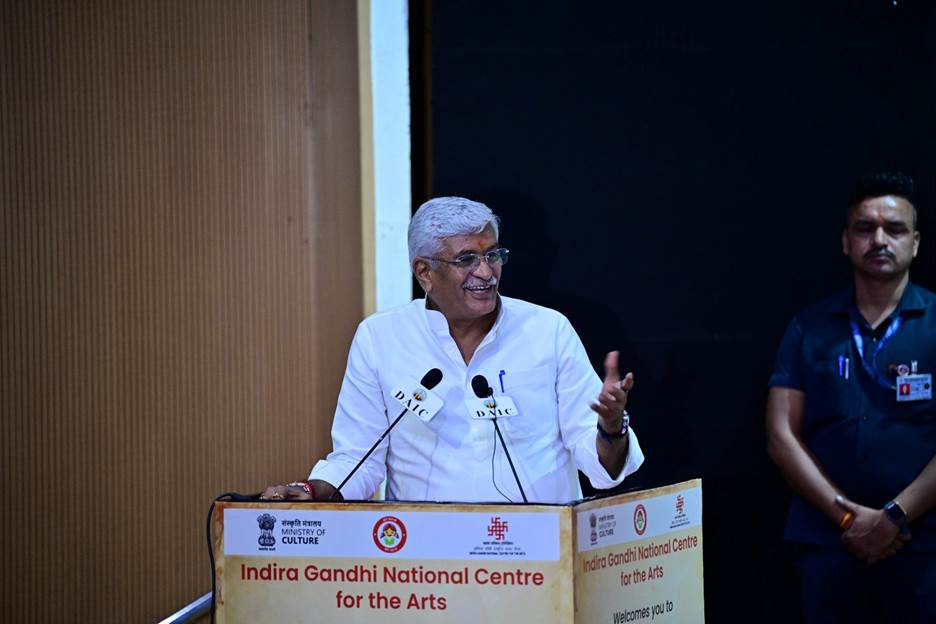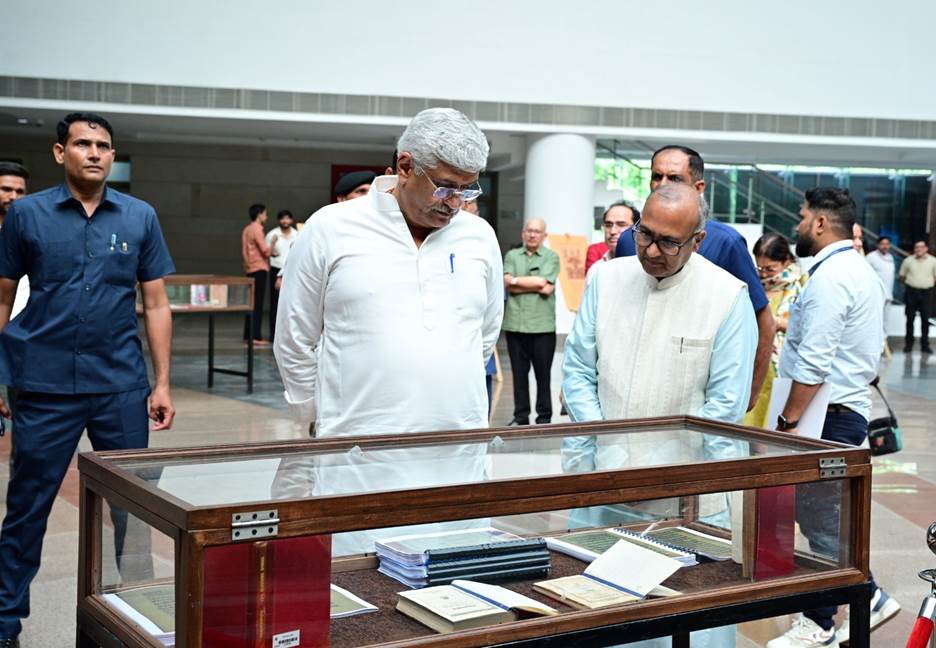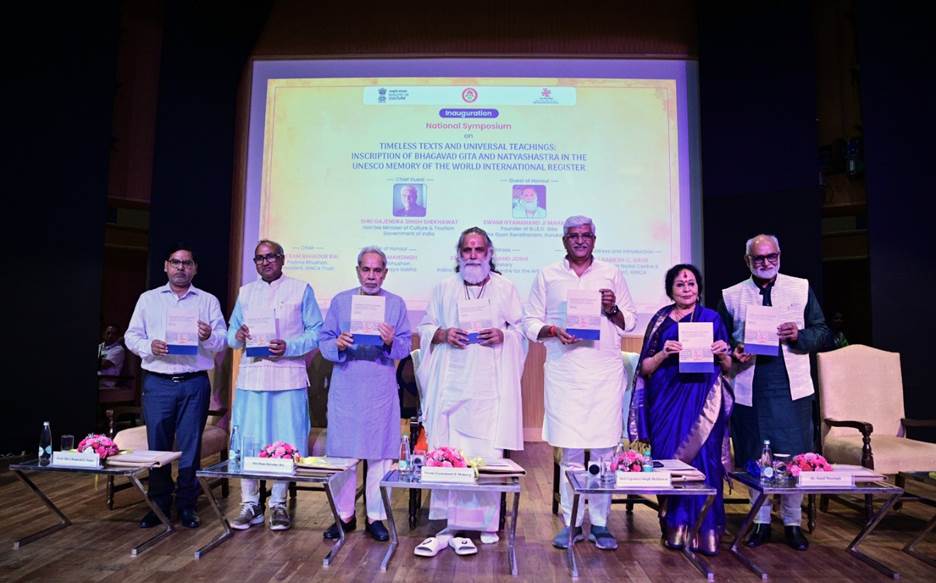Ministry of Culture
“The Gita has remained relevant for 5,000 years and will continue to be so” – Gajendra Singh Shekhawat
IGNCA is hosting two-day symposium to mark the inscription of Bhagavad Gita and Bharatmuni’s Natyashastra in the UNESCO Register
Posted On:
30 JUL 2025 9:49PM by PIB Delhi
The Indira Gandhi National Centre for the Arts (IGNCA) is hosting a two-day national symposium to mark the inscription of the Bhagavad Gita and Bharatamuni’s Natyashastra in the UNESCO Memory of the World International Register. The inaugural session of the symposium was held on 30 July, Tuesday, at the Ambedkar International Centre, New Delhi. The theme of the symposium is ‘Timeless Texts and Universal Teachings: Inscription of the Bhagavad Gita and Natyashastra in the UNESCO Memory of the World International Register.’

The Minister of Culture and Tourism, Shri Gajendra Singh Shekhawat, graced the occasion as Chief Guest. The session was presided over by Padma Bhushan Shri Ram Bahadur Rai, President, IGNCA Trust. The Guests of Honour included Swami Gyananand Ji Maharaj, Founder of G.I.E.O. Gita and Gita Gyan Sansthanam, Kurukshetra, and Padma Vibhushan Dr. Sonal Mansingh, former Member of Parliament (Rajya Sabha). Dr. Sachchidanand Joshi, Member Secretary, IGNCA, delivered the inaugural address, while Prof. (Dr.) Ramesh Chandra Gaur, In-charge, UNESCO Memory of the World Nodal Centre and Dean (Administration), IGNCA, delivered the welcome address and introduced the guests. It is noteworthy that IGNCA played a crucial role in securing the inclusion of these two foundational Indian texts-the Bhagavad Gita and Natyashastra-in the UNESCO Memory of the World International Register.

In his address, Shri Gajendra Singh Shekhawat said, “Undoubtedly, the knowledge of the Gita dates back over 5,000 years, and Bharatamuni’s Natyashastra over 2,500 years. Many nations today, which claim global influence and post on social media as torchbearers of civilisation, perhaps did not even exist back then. And yet, in that ancient era, India had already articulated a nuanced and detailed treatise on the performing arts. One can only imagine the cultural zenith we had attained at the time. The wisdom of the Gita is ‘sarvabhuta’- meant for all living beings. Its global recognition by UNESCO is therefore not only apt but essential. I believe its inscription in the World Memory Register carries profound significance, especially because, perhaps due to the lingering colonial mindset, we have long accepted that what comes from the West is inherently superior. But now that the West has acknowledged it, I hope the younger generation, disconnected from its roots due to the colonial legacy, will begin to recognise and take pride in our rich inheritance.” He added that the Gita has remained relevant for 5,000 years and will continue to resonate for millennia to come. He congratulated both IGNCA and the Bhandarkar Oriental Research Institute (BORI) for this historic achievement.

Swami Gyananand Ji Maharaj remarked, “We live in a digital age. If we remove the first two letters ‘D’ and ‘I’ and the last letter ‘L’ from the word ‘DIGITAL’, what remains is ‘GITA’. When the Gita resides in the heart, even technology finds the right direction. The Gita teaches us values-familial and societal. In today’s fast-paced technological era, the Gita’s message offers us the wisdom to take balanced decisions and walk the path of harmony.”
Dr. Sonal Mansingh observed that the inclusion of both texts-Bhagavad Gita and Natyashastra-in UNESCO’s International Register is, an honour to UNESCO itself. Drawing parallels between the two texts, she highlighted their shared emphasis on karma yoga. While the Gita enshrines the teaching of ‘nishkama karma’ through ‘karmanyevadhikaraste’, the Natyashastra encourages the artist to strive for their finest expression, with the outcome residing in the audience’s experience. Both texts, she said, view action as a form of spiritual discipline-where Krishna’s counsel and the soul of ‘Natyashastra’ converge in yoga and surrender.
Shri Ram Bahadur Rai stated that the inclusion of the Bhagavad Gita and Natyashastra in the UNESCO Memory of the World Register is not merely a ceremonial honour but marks the beginning of a far-reaching cultural journey-one that holds the potential to guide the global community toward dharma, democracy, and self-awareness. It is a recollection of a tradition where Krishna dispels delusion through dialogue, and Bharatamuni elevates art into a sacred discipline.
Dr. Sachchidanand Joshi remarked that while the Gita needs no validation, its inscription in the UNESCO International Register signifies its universal importance. Similarly, the Natyashastra’s global relevance is affirmed through this recognition. He noted that the nomination dossiers for both were meticulously prepared by IGNCA scholars. He added, “If today we can read a manuscript, it is because centuries ago a dedicated scholar preserved it with utmost care. In the same way, the work being done today will be read two or three hundred years hence.” He also mentioned the Government of India’s newly launched mission, Gyan Bhāratam.
Prof. Ramesh Chandra Gaur stated, “The inscription of the Bhagavad Gita and Natyashastra in UNESCO’s Memory of the World International Register is not merely a moment of celebration, but a historic affirmation of India’s civilisational knowledge systems on a global platform. Under the leadership of Shri Ram Bahadur Rai and Dr. Sachchidanand Joshi, IGNCA played a vital role as the nodal agency in preparing and presenting these nominations, reaffirming its commitment to safeguarding India’s documentary heritage.”
On this occasion, a book titled ‘From Manuscript to Memory’ was released, reflecting on the archival and cultural significance of these inscriptions. An exhibition on the same theme was also launched, offering visitors a glimpse into rare manuscripts, historical records, and curatorial interpretations that foreground the journey of these texts from ancient knowledge to global recognition. Shri Vishal V. Sharma, Ambassador and Permanent Representative of India to UNESCO, Paris, shared a special video message acknowledging the contributions of IGNCA and reaffirming the importance of these texts as part of the global intellectual heritage.
It is significant to note that this symposium has been organised in honour of the inclusion of these two seminal Indian texts in the prestigious UNESCO Memory of the World International Register, with the objective of highlighting their global significance and enduring relevance. The valedictory session of the symposium will be held on 31st July 2025 at 5:00 PM at the Samvet Auditorium, IGNCA, Janpath. Shri Vivek Aggarwal, Secretary, Ministry of Culture, Government of India, will be present as Chief Guest, while Prof. Shrinivasa Varakhedi, Vice Chancellor of the Central Sanskrit University, New Delhi, will be the Guest of Honour. The session will be chaired by Dr. Sachchidanand Joshi, and Prof. Ramesh Chandra Gaur will deliver the welcome address and present a brief summary of the discussions. Multiple sessions will be held throughout the day. Through this symposium, IGNCA seeks to bring together scholars, cultural thinkers, and heritage professionals to reflect upon the timeless wisdom embedded in the Bhagavad Gita and Natyashastra, and to reaffirm their relevance as living texts in contemporary global discourse.
Multiple sessions are scheduled throughout the day. Through this symposium, IGNCA seeks to convene scholars, cultural thinkers, and heritage professionals to engage with the timeless wisdom enshrined in the Bhagavad Gita and Natyashastra, and to reaffirm their relevance as living texts in contemporary global discourse. The event concluded with a formal vote of thanks delivered by Dr. Mayank Shekhar.
****
Sunil Kumar Tiwari
pibculture[at]gmail[dot]com
(Release ID: 2150483)
Visitor Counter : 109